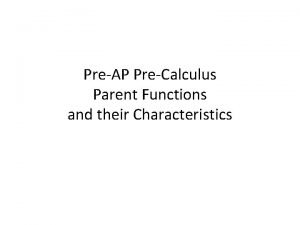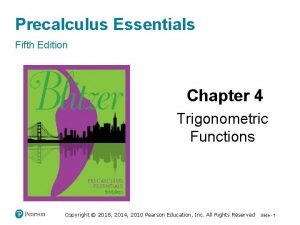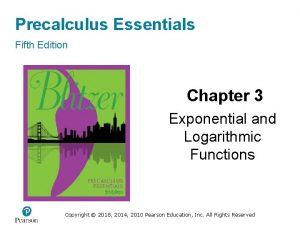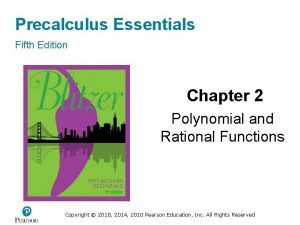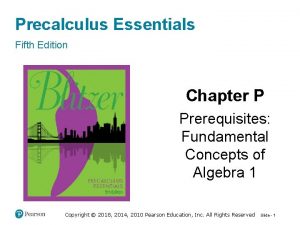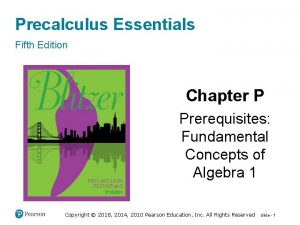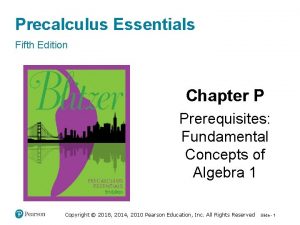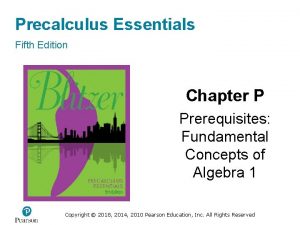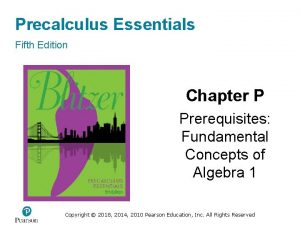Precalculus Essentials Fifth Edition Chapter 1 Functions and












- Slides: 12

Precalculus Essentials Fifth Edition Chapter 1 Functions and Graphs Copyright © 2018, 2014, 2010 Pearson Education, Inc. All Rights Reserved

1. 5 More on Slope Copyright © 2018, 2014, 2010 Pearson Education, Inc. All Rights Reserved

Objectives • Find slopes and equations of parallel and perpendicular lines. • Interpret slope as rate of change. • Find a function’s average rate of change. Copyright © 2018, 2014, 2010 Pearson Education, Inc. All Rights Reserved

Slope and Parallel Lines 1. If two nonvertical lines are parallel, then they have the same slope. 2. If two distinct nonvertical lines have the same slope, then they are parallel. 3. Two distinct vertical lines, both with undefined slopes, are parallel. Copyright © 2018, 2014, 2010 Pearson Education, Inc. All Rights Reserved

Example: Writing Equations of a Line Parallel to a Given Line Write an equation of the line passing through (− 2, 5) and parallel to the line whose equation is y = 3 x + 1. Solution: Express the equation in point-slope form. y = 3 x + 1 The slope of the line is 3. A parallel line will have slope of 3. y − 5 = 3(x − (− 2)) → y − 5 = 3(x + 2) In point-slope form, the equation of the line is y − 5 = 3(x + 2). Copyright © 2018, 2014, 2010 Pearson Education, Inc. All Rights Reserved

Slope and Perpendicular Lines 1. If two nonvertical lines are perpendicular, then the product of their slopes is − 1. 2. If the product of the slopes of two lines is − 1, then the lines are perpendicular. 3. A horizontal line having zero slope is perpendicular to a vertical line having undefined slope. Copyright © 2018, 2014, 2010 Pearson Education, Inc. All Rights Reserved

Example: Writing Equations of a Line Perpendicular to a Given Line Find the slope of any line that is perpendicular to the line whose equation is x + 3 y − 12 = 0. The slope of any line perpendicular to this line is 3. Copyright © 2018, 2014, 2010 Pearson Education, Inc. All Rights Reserved

Slope as Rate of Change Slope is defined as the ratio of the change in y to a corresponding change in x. It describes how fast y is changing with respect to x. For a linear function, slope may be interpreted as the rate of change of the dependent variable per unit change in the independent variable. Copyright © 2018, 2014, 2010 Pearson Education, Inc. All Rights Reserved

Example: Slope as Rate of Change (1 of 2) In 1990, 9 million adult men in the United States lived alone. In 2008, 14. 7 million adult men in the United States lived alone. Use this information to find the slope of the linear function representing adult men living alone in the United States. Express the slope correct to two decimal places and describe what it represents. Solution: We form the ordered pairs (1990, 9) and (2008, 14. 7). Copyright © 2018, 2014, 2010 Pearson Education, Inc. All Rights Reserved

Example: Slope as Rate of Change (2 of 2) Using the ordered pairs (1990, 9) and (2008, 14. 7), we compute the slope: The number of men living alone increased at a rate of 0. 32 million per year. The rate of change is 0. 32 million men per year. Copyright © 2018, 2014, 2010 Pearson Education, Inc. All Rights Reserved

The Average Rate of Change of a Function Let (x 1, f(x 1)) and (x 2, f(x 2)) be distinct points on the graph of a function f. The average rate of change of f from x 1 to x 2 is Copyright © 2018, 2014, 2010 Pearson Education, Inc. All Rights Reserved

Example: Finding the Average Rate of Change Copyright © 2018, 2014, 2010 Pearson Education, Inc. All Rights Reserved
 Precalculus sixth edition
Precalculus sixth edition Parent functions symmetry
Parent functions symmetry Business essentials 12th edition chapter 1
Business essentials 12th edition chapter 1 Principles of marketing fifth european edition
Principles of marketing fifth european edition Appraisals in lazarus's theory of emotion
Appraisals in lazarus's theory of emotion Fundamentals of corporate finance fifth edition
Fundamentals of corporate finance fifth edition Democritus atomic model diagram
Democritus atomic model diagram Molecular biology
Molecular biology Molecular biology of the cell fifth edition
Molecular biology of the cell fifth edition Human anatomy fifth edition
Human anatomy fifth edition Human anatomy fifth edition
Human anatomy fifth edition Precalculus honors chapter 1 test
Precalculus honors chapter 1 test Network security essentials 5th edition
Network security essentials 5th edition

